The planets are aligning! The week ahead will feature multiple planetary conjunctions at dawn and great views of Neptune and Triton at nightfall.
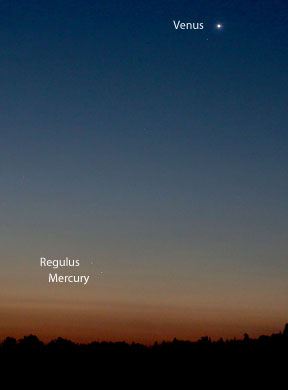
Bob King
My wife has me asked me more than once about taking ballroom dance lessons. She'd love to get back to the dance floor. Me, too — as soon as time allows. Until then, I'm going to leave the dancing to the stars. Well, planets mostly. In the coming week, there will be no fewer than seven conjunctions between Regulus, Venus, Mars, Mercury and the crescent Moon at dawn.
North American observers have the best seats for several of the events, while others are best seen from Europe or the western Pacific. But no matter where you live, this bunch slides and shimmies within close proximity of each other for seven mornings and then some.
As we spin the clock forward, the interweaving motions recall a square dance, each planet changing position according to its own orbital motion and touched by Earth's own travels around the Sun. Mercury reached greatest elongation on September 12th and is now well placed for skywatchers in the Northern Hemisphere this week.
To begin, find a location with a wide open eastern horizon. This is where all the action's happening. And bring binoculars to help you search out the planets. Some, like Mars, are fainter and closer to the horizon than others and need a little help. You needn't to go out just during the conjunctions either. Every single morning over the next week will offer a new and unique celestial arrangement.
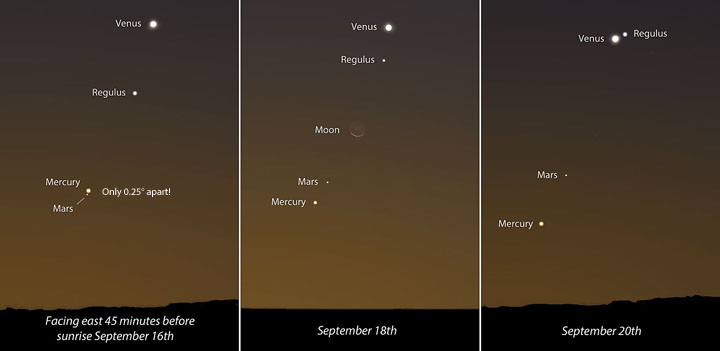
Stellarium
Lucky for us, Venus will shine nearby the entire time, a trusty guide to the action happening closer to the horizon. I encourage you to take a camera along to capture some of these celestial do-si-dos. Photography is easy in dawn light because exposures are short. You'll need a tripod, the lens set to f/2.8 or 4.0, ISO 400 and a brief 1- to 5-second exposure.
Here we go:
- The gap between Mercury and Mars shrinks until September 16th, when they'll be in kissy-face conjunction, only 15′ (arcminutes) apart as seen from eastern North America, 10′ apart for the West Coast, and 3′ for Japan and the western Pacific on September 17th local dawn time. Mercury, shining at magnitude 0.0, passes to the north of dimmer Mars, at magnitude 1.8.
- September 18th: Venus, Regulus, Mars, Mercury, and a thin lunar crescent form a celestial conga line 11.5° long at dawn. Like an itinerant preacher going from town to town, the Moon on the 18th will be in conjunction with Venus (1h UT), Regulus (5h UT), Mars (19h UT), and Mercury (23h UT). None of these will be a close conjunction for the Americas, but observers in much of Europe will see the Moon pass only minutes of arc south of Regulus on the 18th with an occultation visible from southeastern Europe and points east and south.
- September 19–20th: Venus passes just ½° from Regulus. Best in Europe on the morning of the 19th; in the Americas, they'll be closest (~35′) on the 20th at dawn.
- October 5: The series of close dawn conjunctions wraps up when Venus passes just ¼° north of Mars for the Americas at dawn.
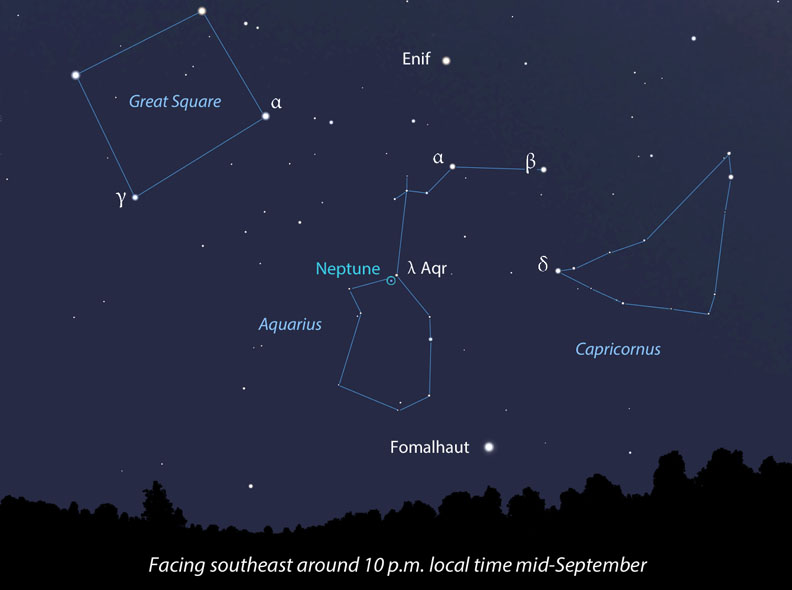
Stellarium
Meanwhile, in the evening sky, Neptune reached opposition on September 5th and now invites a look in the southeastern sky starting around 9:30-10 p.m. local time. We're fortunate that the most distant and faintest of the planets sits less than 1° southeast of the easy naked-eye star Lambda (λ) Aquarii and it never strays farther from it until next February.
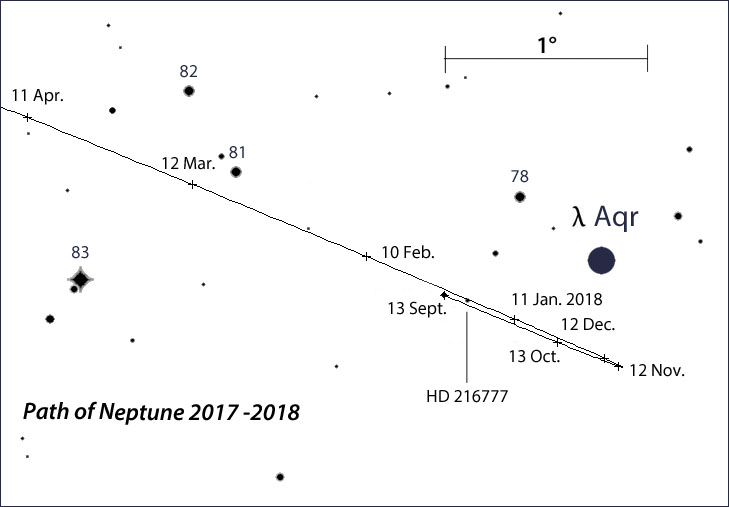
Chris Marriott's SkyMap
Plunk a low magnification eyepiece in your scope, point it at Lambda and shift about a field of view to the southeast to spot a pale blue, magnitude 7.8 "star." That'll be Neptune. Lambda serves as a convenient guide to the planet whether you're using binoculars (7×35s will grab it under reasonably dark skies) or a telescope. Point your instrument at the star and shift about a field of view to the southeast to spot Neptune. At low magnifications (30×–70×) the planet looks like a pale blue star, but its 2.4-arcsecond disk expands expands into a plump period at 150×–200×.
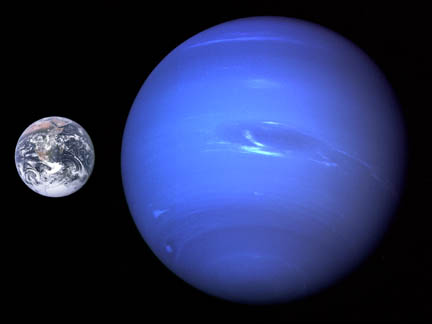
NASA
A most opportune time to watch the planet move track against the background stars happens over the next few nights, when Neptune skims just south of 8th-magnitude HD 216777. Closest approach occurs September 18th when the planet and star will look like a wide double star separated by just 1.3 arcminutes.
High-resolution astrophotography will reveal occasional details on Neptune's cloudy disk, but all I've ever seen are slight changes in color most likely brought on by physical changes within my own eyeballs. The pleasure of Neptune derives from the mind's eye. While absorbing its cool, blue, methane personality consider these highlights:
- Neptune takes nearly 165 years to make one spin around the Sun, about twice the average human lifespan;
- This ice giant possesses five rings composed of ice grains and dust coated with a carbon-based substance;
- Peak winds clock at 2,400 kph (1,500 mph), faster than those on any other planet in the solar system. Neptune's internal heat powers these super-winds. Can't count much on the Sun when it's 4.5 billion km (2.8 billion miles) away;
- The planet's average temperature of –353° F (–214° C) is a few degrees below the freezing point of nitrogen;
- Neptune has the only large moon in the solar system — Triton — that revolves around its host planet backwards.
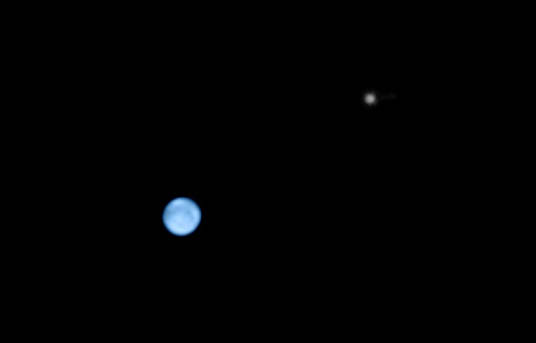
Damian Peach
The big surprise at Neptune is that despite its spectacular distance, seeing Triton is relatively easy in 10-inch and larger telescopes. The moon circles Neptune from west to east every 5.9 days, inclined 157° to the planet's equator. At greatest elongation, the best time to seek it, Triton stands off 15 arcseconds either the northeast or southwest of the planet and shines at around magnitude 13.5. Visit Sky & Telescope's Triton Tracker and play around with dates know exactly when and where to see it best.
Path of Totality: Eclipse 2017
And now for a treat. If you can spare 5 minutes and 24 seconds, you won't be disappointed. This wonderful slide show is set to music composed by David Fogel inspired by the August 21st total eclipse. Fogel's an amateur astronomer, musician, and composer who lives in La Jolla, California. Stirred by the sight of totality in Rexburg, Idaho, he composed the piece and then worked with Joe Woolbright of Sparta, Illinois, who took still images of the entire event, to create the video.
I think the music and photos mesh well for a fitting farewell to a wonderful event so many of us shared. Enjoy.
 13
13









Comments
Tom-Reiland
September 14, 2017 at 3:54 am
Sunday night I was at Wagman Observatory on the 21" scope and I started the evening with Jupiter and Saturn. Once Neptune and Uranus were high enough, I observed them and Triton. I closed up after Moonrise and headed home. About 5 AM I could see Venus just above the ridge to the East of my house. I waited until 6 AM and drove up the hill to a location with a clear Eastern horizon a mile from my place. I spotted Venus again, Mercury near Regulus and Mars just above the horizon. I used my 10 X 50 binocs and my 5" Jaegars Refractor at 31.5X. It's not often we have a chance to see all the planets in one night. It's easier now that Pluto is no longer classified as one.
I've noticed that the smoke has moved into our sky that has plagued you for some time. I hope for all concerned that they put out these fires very soon. I also observed the recently discovered SN in NGC 6824 in Cygnus. It's slightly fainter than 14 mag. I didn't have any magnitudes for nearby reference stars to get a good estimate of it. We're dealing with the remnants of Irma now. I hope it clears out. soon and I hope you have smokeless skies in the very near future..
You must be logged in to post a comment.
Anthony Barreiro
September 15, 2017 at 4:25 pm
Well done, Tom! I consider observing all the major planets in one night a solar system bingo. You could also add one or two main belt asteroids as a wildcard. Iris and Pallas are coming into good view for the next couple of months.
You must be logged in to post a comment.
Tom-Reiland
September 16, 2017 at 7:25 am
I gave it another shot last night into this morning. I had to wait for some holes in the only clouds in the sky, the Eastern horizon, to see Mercury and Mars close together and Venus well above them with the Crescent Moon in Cancer. I was able to see the Moon and Venus from my backyard before I drove to the Middle Road Fire Hall to look for the two smallest planets.
Another three location night of observing. While I was at Wagman Obs, I observed the other five planets, including Earth, of course. I saw three of Jupiter's Moons, four of Saturn's, Triton with Neptune and Titania and Oberon with Uranus. Throw in Asteroid #89, Julia for 20 solar system objects in one night.
I took another look at SN 2017 glx in NGC 6824 and it's about 14.5 mag. I was able to find SN 2017 gmr in NGC 988, though I could not see the galaxy because of the 7.5 magnitude star in front of it and the bright sky conditions in the SE. This Supernova is at 14 magnitude and was visible at 127X, 282X and 462X. I forgot to bring a chart for Comet ASASSN1 in Taurus. Maybe next time.
You must be logged in to post a comment.
Bob KingPost Author
September 16, 2017 at 12:15 pm
What a great night, Tom. I'm eager for the rain to move out here, so I can get my dawn planet vitamins as well as check on the SN in NGC 988. Have you tried mag. 14.4 2017glx in NGC 6824. It's high in the evening sky at nightfall. The galaxy is easy to see but use high magnification as the SN is near the nucleus.
You must be logged in to post a comment.
Tom-Reiland
September 16, 2017 at 4:56 pm
I mentioned 2017glx in my post of Sep 14 and also this morning's post. I did use high magnification both nights. It's easy at 282X and 462X on the 21". I'm hoping that the morning of Sep 18 is clear enough to see the Crescent Moon in between the three planets.
You must be logged in to post a comment.
Anthony Barreiro
September 15, 2017 at 4:42 pm
Thanks Bob! I've been enjoying the dawn dance for the past week. I have a clear view to the east from my back steps, and we've had a couple of very clear mornings. Sunday I caught Mercury's conjunction with Regulus. This morning I saw Mercury rising through the trees on the horizon, twinkling madly, with Venus and Regulus above. Mars rose a few minutes later. This morning was the first time I have been able to see Mars naked eye. Seeing a bright planet rise helps me imagine that I'm feeling Earth's rotation, and I love creating a mental picture of where all the planets are in our orbits around the Sun.
Neptune never gets high enough for a clear view from the back yard, but Uranus has been fun to find through binoculars. I can't see the stars of Pisces through my horrible urban light pollution, but a line from Beta through Gamma Arietis points straight to Omicron Piscium with Uranus nearby. (This year's S&T finder charts for Uranus don't include Aries, but they should.)
You must be logged in to post a comment.
Anthony Barreiro
September 15, 2017 at 5:46 pm
P.S. The eclipse video with piano fantasia is lovely.
You must be logged in to post a comment.
Bob KingPost Author
September 16, 2017 at 12:15 pm
Anthony,
I agree on the video. Very well done.
You must be logged in to post a comment.
Bob KingPost Author
September 16, 2017 at 12:18 pm
You're welcome, Anthony. Glad to hear you got such good views of the planets. I'm hoping for Sunday morning.
You must be logged in to post a comment.
Tom-Reiland
September 18, 2017 at 6:33 am
I got one last view of the grouping of Venus, Regulus, The Moon, Mars and Mercury this morning from the Fire Hall a mile east of my house with an unobstructed Eastern horizon. I also witnessed a nice ISS pass that moved very close to Procyon while I was there. I needed my 10 X 50 binocs to see Regulus, Mars and Mercury because of the haze and local light pollution. Time to finish reading the morning paper and head for bed.
You must be logged in to post a comment.
Anthony Barreiro
September 18, 2017 at 7:54 pm
At my astronomy club's star party on Mt. Tam Saturday night, I found Neptune in mounted 15x70 binoculars, looking like a wide double star with an 8th magnitude true star about a degree southeast of lambda aquarii. It looked stellar, but a very slight bluish tinge was visible. Several other members with big dobsonians got oriented by looking through my binoculars and were then able to find Neptune in their dobs. The seeing was poor, so even with lots of aperture and high magnification, Neptune just looked blurrier through the big scopes.
You must be logged in to post a comment.
Bob KingPost Author
September 19, 2017 at 10:02 am
Anthony,
With planets it's all about seeing. That "wide double" separation was 3.5' on Saturday, closest yesterday but still only 2' tonight.
You must be logged in to post a comment.
Anthony Barreiro
September 19, 2017 at 5:47 pm
Oh yeah, HD 216777. Thanks Bob. The color contrast made it easier to tell which was Neptune.
People are often surprised how much you can see through binoculars. The mount keeps everything steady, allows you to go back and forth to a chart to star-hop to a faint object, and lets you share the view with others.
You must be logged in to post a comment.
You must be logged in to post a comment.